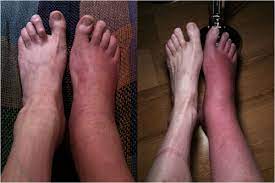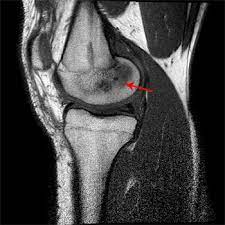
 Bone marrow edema (BME) occurs when fluid builds up in the bone marrow.
Bone marrow edema (BME) occurs when fluid builds up in the bone marrow.
Bone marrow edema syndrome is a diagnosis of exclusion.
It is characterized by pain and increased interstitial fluid within bone marrow without an obvious cause.
There is evidence that this phenomenon is associated with metabolic disturbances, including vitamin D deficiency.
It is frequently misdiagnosed as its clinical presentation is highly variable and nonspecific.
Bone marrow edema may occur due to:
There are two types of bone marrow edema:Primary and secondary.
Bone marrow edema syndrome (BMES) is a rare type of BME with an unknown cause.
It’s most common in men between the ages of 30 and 60.
BMES may be related to high cholesterol and low vitamin D.
It can show up in one bone or in many bones and most commonly occurs in the lower part of the body.
Risk factors for bone marrow edema,
Arthritis.
Bone cancer
Bone infections (osteomyelitis)
Osteoporosis.
Several types of health conditions may lead to bone marrow edema:
Types of cancer that may cause BME include:
Acute myeloid leukemia (AML).
Bone metastasis.
Chondrosarcoma.
Ewing sarcoma.
Osteosarcoma.
Radiation therapy for cancer.
Conditions with impaired blood or oxygen to organs may lead to BME include:
Avascular necrosis
Charcot foot.
Metabolic conditions
Issues with metabolism that may cause BME include:
Cushing syndrome.
Hyperparathyroidism.
Mastocytosis.
Mineral and bone disorders due to chronic kidney disease.
Osteomalacia.
Osteoporosis, especially of the hip and knee.
Vitamin D deficiency.
Musculoskeletal inflammation
Inflammation of bones, ligaments, muscles, nerves and tendons may cause BME include:
Ankylosing spondylitis (AS).
Enthesitis
Psoriatic arthritis.
Rheumatoid arthritis.
Sacroiliitis.
Trauma
Types of injuries that may cause bone marrow edema include:
ACL (anterior cruciate ligament) tears.
Complex regional pain syndrome (CRPS).
Compression fractures.
Hip osteonecrosis
Other bone or joint injuries, especially of the ankle, hip, knee or spine.
Stress fractures, especially in the ankle, foot, hip or knee.
The main symptom of bone marrow edema is pain around or in the bone.
Other symptoms may include:
Joint effusion (swollen joints).
Warm joints.
Some people with BME may not have any symptoms.
Diagnosis: clinical exam, blood tests, to look for signs of inflammation.
Bone marrow biopsy.
DEXA (DXA) scan, to look for osteoporosis.
MRI.
Ultrasound.
Bone marrow edema usually goes away on its own.
Bone marrow edema syndrome has been described in pregnant women during the third trimester, and cirrhosis and type IV hyperlipoproteinemia are associated with an increased incidence of bone marrow edema syndrome.
Bone marrow edema syndrome is a condition of the lower extremities in 98% of cases and rarely appears in the upper limbs.
Middle-aged men (aged 30 to 60) and young women (aged 20 to 40) are most likely to be affected.
The incidence of bone marrow edema 3 to 1 in men and women.
Bone marrow edema syndrome is often a migratory phenomenon.
Bone marrow edema syndrome occurs bilaterally in 41% of patients.
The pathogenesis of bone marrow edema syndrome is unknown.
The pain of bone marrow edema is likely due to aggravation of neurovascular bundles within the bone marrow due to increased intraosseous pressure caused by the increased fluids in the bone marrow interstices.
Histologic findings in bone marrow edema syndrome shows bony trabeculae containing osteoid seams, new bone formation, and vascular reconstruction with under-mineralized bone.
Bone repair through turnover is likely the reason for the natural regression of the symptoms.
Patients with bone marrow edema often present with complaints of severe pain that limits functionality and daily activities.
Pain and swelling occur during rest and activity, which may occur suddenly or insidiously.
Point-tenderness and noticeable swelling in the area of the syndrome may occur.
Arthralgias and joint effusion are not common.
The bone marrow edema syndrome can be divided into three phases:
The first month is characterized by initial pain and dysfunction.
Second phase, is one to two months characterized by maximum pain levels.
In the third phase symptoms regress over the next few months.
Both the presentation and resolution of symptoms are highly variable.
X-rays begin to show osteopenia a month or two after the presentation of symptoms.
Computed tomography (CT) scans may assess local demineralization, as well as to rule out other causes of pain and swelling such as malignancy or infection.
MRI is a much better test for the assessment of bone marrow edema syndrome, as edema can be detected within two days of symptom onset, showing a decreased signal on T1 weighted images and an increased signal on T2 images.
Blood work is typically negative.
Decreased levels of vitamin D may be present.
Bone marrow edema syndrome is self-limiting, and treatment is primarily symptom management.
Offloading of the affected region, nonsteroidal anti-inflammatory drugs (NSAIDs) and physical therapy remain the mainstays of symptomatic management.
Nifedipine a calcium channel blocker and sympathetic nerve blockade may provide pain relief in the treatment of bone marrow edema syndrome.
Iloprost is a prostacyclin analog improves functionality and pain in patients with bone marrow edema syndrome.
Of note, prostacyclin analogs are contraindicated in patients receiving anticoagulants and during pregnancy, a common comorbidity for bone marrow edema syndrome.
Bisphosphonates and vitamin D supplementation may also be used to increase anabolism and revascularization of bone.
Bisphosphonates have been shown to have an analgesic effect in addition to their anabolic effects within bone tissue.
Bone marrow edema syndrome is a diagnosis of exclusion.
Differential diagnosis: Trauma, malignancy, infection, osteonecrosis, complex regional pain syndrome, stress fractures.
Bone marrow edema syndrome is self-limiting with
Pain with BMES typically peaks at about one to two months after onset and completely resolves within three to nine months.
The pain associated with bone marrow edema is often debilitating and stressful.
